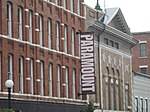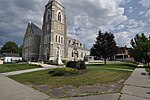Rutland Downtown Historic District, is the center of government for Rutland, Vermont. The sector of "downtown" is roughly defined as the area between Strongs Avenue, State, Wales, Washington, Pine, and Cottage Streets. The area is also a major center for business, and is considered the most cultural part of Rutland. Much of the area is also listed on the National Register of Historic Places as a historic district and includes 90 contributing properties. Some of these buildings date to the late 18th century, when Rutland was founded, but the greatest amount of expansion in downtown came after the marble industry became established on a large scale after 1850. The city's population tripled between 1850 and 1880, and many of the buildings built in this period were either built with or ornamented with marble.In the 1890s, the arts flourished in Rutland, especially in music, literature, and theater. Julia Caroline Dorr spurred much of the appreciation of the arts. Her father had built the original Rutland Opera House, and later rebuilt it after a fire destroyed the original structure. In 1913, George Chaffee built another theatre, the Playhouse. The exterior of the Playhouse had a classical style reflecting the City Beautiful movement of the time, while the interior resembled a Victorian era opera house with lavish decoration. The theatre was renamed The Paramount in 1931, and its entertainment shifted from live performance to movies. The movie theater closed in 1975. In 1999, a local group began restoring the theatre to its historic appearance. The theatre reopened in March 2000 and serves again as a center for artistic, cultural, and educational events.








